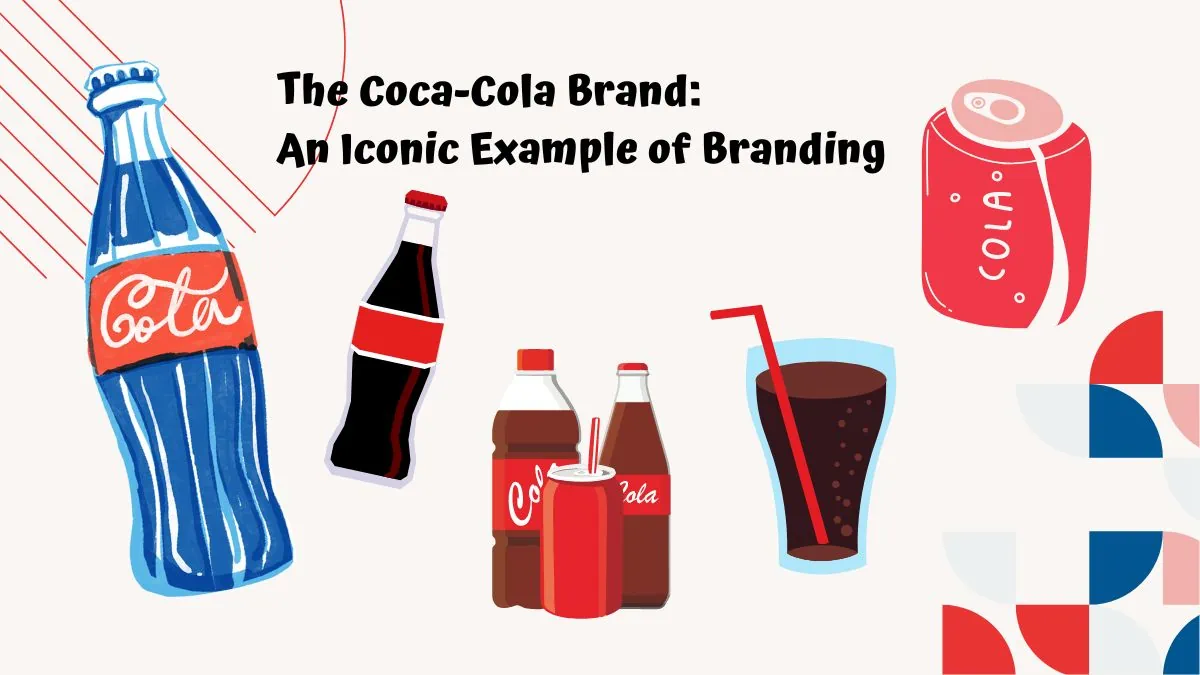
Imagine that you’re in a grocery store, walking down the beverage aisle.
Amidst the myriad of colors and logos, one particular design catches your eye – a familiar red label with a white script that reads: Coca-Cola.
Instantly recognizable, isn’t it? There lies the magic of the Coca-Cola brand.
Coca-Cola is more than just a beverage company. It’s a global brand that symbolizes a lifestyle, an attitude.
A symbol of joy, refreshment, and unity, it’s a brand that has successfully bridged cultures and continents. Its profound success can be credited to more than just its secret formula or famous Coca-Cola products.
The true essence of Coca-Cola lies in its powerful and iconic branding.
The Birth of Coca-Cola Brand
The story of Coca-Cola began in 1886 when a pharmacist named John S. Pemberton concocted a sweet, caramel-colored liquid and mixed it with carbonated water. The result was a refreshing beverage that was initially sold for five cents a glass at the local soda fountain.
The branding of Coca-Cola, however, was the brainchild of Pemberton’s bookkeeper, Frank M. Robinson. Robinson not only named the drink “Coca-Cola” but also designed its now-famous script logo. He believed that the two Cs would look striking in advertising – and he couldn’t have been more right. The Coca-Cola logo has now become one of the most recognized brand symbols globally, laying the foundation of a brand that would become an integral part of popular culture.
The Evolution of the Coca-Cola Logo
From its inception, the Coca-Cola logo has been a cornerstone of the brand’s identity. The logo’s elegant Spencerian script, named after calligrapher Platt Rogers Spencer, has remained largely unchanged since its creation in 1886.
The first major evolution came in 1947 when the Arciform or “fishtail” logo was introduced. It featured the Coca-Cola script inside an arc shape, symbolizing a friendly, dynamic, and approachable brand.
In 1969, the Arden Square logo was introduced, which enclosed the logo inside a red square or rectangle. This design has been modified slightly over the years, but the classic white script on a red background has remained consistent, signifying the brand’s commitment to its roots, while adapting to the evolving marketplace.
The consistency in the Coca-Cola brand identity over more than 130 years is a testament to the power of strong visual branding. It underlines the brand’s ability to evolve with the times, while staying true to its identity – an element crucial to its widespread recognition and appeal.
The Coca-Cola Company Brand Message and Taglines Over the Years
Since its birth, Coca-Cola has conveyed a consistent brand message: sharing, happiness, and refreshment. This message has been amplified through a series of memorable taglines that resonate with consumers worldwide.
Starting with “Drink Coca-Cola” in 1886, the company’s taglines evolved with the changing times and market needs. From “Delicious and Refreshing” (1904), encapsulating the beverage’s unique selling proposition, to “The Pause That Refreshes” (1929), addressing the growing fast-paced lifestyle of the American public.
Perhaps one of the most iconic taglines was “It’s The Real Thing” (1969). Amidst a period of political and social change, this slogan anchored Coca-Cola as a genuine, authentic experience. Later, “Always Coca-Cola” (1993) and “Open Happiness” (2009) further deepened the brand’s association with joy and positivity.
Most recently, “Taste the Feeling” (2016) combines the refreshment of the Coca-Cola drink with the emotional resonance of its brand. Each tagline represents a snapshot of the brand’s evolution, marking its journey as a constant provider of refreshment, joy, and shared happiness.
The Iconic Coca-Cola Bottle Design
The Coca-Cola bottle, colloquially known as the “contour bottle” or the “hobble skirt” bottle, is another cornerstone of the Coca-Cola company’s branding.
Created in 1915 by the Root Glass Company, the bottle design was a response to a challenge set by Coca-Cola: to create a bottle that could be recognized in the dark or even if broken.
The result was a unique, curvaceous bottle, inspired by the ridged shape of a cocoa pod. Its design was not only distinctive but also ergonomic, fitting perfectly in the hand. In 1960, it was registered as a trademark by the U.S. Patent Office – an unusual feat for a commercial package.
The Coca-Cola bottle embodies the brand’s commitment to innovation, uniqueness, and customer experience. Its timeless design remains largely unchanged, making it an enduring symbol of the brand and a classic piece of industrial design. Today, whether you see it on a supermarket shelf, on television, or in a social media post, the contour bottle instantly says “Coca-Cola”.
The Role of Color in Coca-Cola’s Branding
Coca-Cola’s success goes beyond its script logo and unique bottle design.
One cannot discuss Coca-Cola’s branding without mentioning its iconic color – Coca-Cola Red. The brand’s consistent use of this vibrant, energizing shade of red has helped it establish a strong, memorable identity and is the basis of any marketing strategy.
The exact shade of Coca-Cola Red is a closely guarded secret.
However, its ubiquity is undeniable. This specific shade of red, often used in tandem with white, gives Coca-Cola packaging its unmistakable look. Whether on a can, a bottle, or an advertisement, this use of color has helped Coca-Cola create a strong visual identity that stands out in a crowd and immediately brings the brand to mind.
The power of Coca-Cola Red exemplifies the strategic use of color in branding. It underscores how Coca-Cola’s marketing team was able to use a consistent and thoughtful color palette to help the brand establish a unique identity, evoke specific emotions, and create a lasting impression on consumers’ minds.
Coca-Cola’s Brand Identity
A critical aspect of Coca-Cola’s branding success is its well-defined and appealing brand identity.
When you think of Coca-Cola, words like “happy,” “refreshing,” “classic,” and “friendly” come to mind.
This isn’t a coincidence; it’s a result of decades of strategic branding and an unbeatable marketing strategy.
The successful brand identity is characterized by traits such as happiness, optimism, and inclusivity. The brand consistently radiates a positive and uplifting energy, whether through its advertising campaigns, social media presence, or corporate social responsibility efforts.
Through its “Share a Coke” campaign, Coca-Cola demonstrates its friendly, personal, and approachable personality, encouraging consumers to create personal connections over a Coke.
Coca-Cola’s brand personality is also shaped by its commitment to unity and diversity. It regularly produces multicultural and inclusive campaigns, conveying a message of unity in diversity, much like its 1971 “Hilltop” commercial with the famous song “I’d Like to Buy the World a Coke.”
A defined and appealing brand identity is integral to building strong emotional connections with consumers. The world-famous soft drink exemplifies this strategy, fostering a strong emotional bond with its audience that goes beyond the product itself.
Coca-Cola’s Global Branding Strategy
Being a successful brand recognized in every corner of the globe doesn’t happen by accident.
Coca-Cola’s global marketing strategy is a masterclass in understanding your audience and crafting messages that resonate on a universal level.
The principle “think global, act local” beautifully encapsulates Coca-Cola’s global strategy and unstoppable marketing efforts.
Despite being an American company, Coca-Cola has excelled in crafting marketing strategies that resonate with diverse cultures and communities worldwide.
Coca-Cola understands the power of local nuances and taps into this by tailoring its advertising and marketing campaigns to suit local tastes and traditions. For instance, during the Chinese New Year, Coca-Cola releases special edition cans featuring auspicious symbols and messages, while in Brazil, it sponsors the country’s beloved football teams – while still maintaining a consistent brand identity.
By striking a balance between maintaining its universal brand messaging of happiness and refreshment, and catering to local cultures and traditions, Coca-Cola has positioned itself as a global brand that understands and celebrates diversity.
How Coca-Cola Keeps Its Branding Relevant
Maintaining relevance is one of the greatest challenges any brand faces, particularly one with a history as long as Coca-Cola’s. The brand has demonstrated an uncanny ability to evolve with changing consumer tastes, societal shifts, and technological advancements.
Coca-Cola’s ability to stay relevant is largely due to its constant innovation and its ability to listen and respond to its consumers. The company regularly introduces new products and flavors to cater to a broader audience and changing consumer preferences. For instance, in response to the growing health-conscious market, Coca-Cola introduced Coke Zero, a no-calorie version of its signature beverage.
Furthermore, Coca-Cola leverages contemporary platforms and technologies to reach and engage with its audience. The brand maintains a strong presence across various social media platforms, regularly produces engaging digital content, and even dabbles in augmented reality experiences to connect with younger audiences.
Through continuous innovation and a commitment to understanding its consumers, Coca-Cola ensures that its branding stays fresh, relevant, and in tune with the times.
Coca-Cola’s Branding During Crises
Like all global brands, Coca-Cola has faced its share of crises. However, its response to these crises has often been marked by an ability to uphold its brand identity while showing empathy and adaptability.
For instance, during the COVID-19 pandemic, Coca-Cola temporarily halted its advertising campaigns to redirect funds to relief efforts. This included donating to non-profit organizations and providing supply chain support to deliver essential goods.
Also, in its advertisements during this time, Coca-Cola focused on messages of solidarity, hope, and gratitude towards frontline workers. For example, the brand released an ad with white text on a red background that read, “Staying apart is the best way to stay united.”
These actions reinforce Coca-Cola’s brand values of optimism and unity, demonstrating how the brand uses its influential position to contribute positively during crises.
Coca-Cola Marketing Mistakes
Despite its undoubted success, the Coca-Cola brand has also had its share of missteps. These mistakes have provided invaluable lessons not only for Coca-Cola but for the world of marketing as a whole.
- New Coke (1985): Perhaps the most infamous marketing blunder in history, New Coke was the result of Coca-Cola’s attempt to rejuvenate its formula. They replaced the original recipe with a sweeter version, but consumers reacted with such intense backlash that the company was forced to bring back the original as “Coca-Cola Classic” just 79 days later. While it still used a similar formula with high fructose corn syrup, the launch was a flop. The New Coke fiasco taught marketers the importance of understanding and valuing consumer attachment to a product.
- Dasani in the UK (2004): When Coca-Cola introduced Dasani bottled water in the UK, they described it as “pure, still water”. However, it was later revealed that Dasani was essentially treated tap water from a local water supply. The scandal tarnished the brand’s reputation and led to Dasani’s withdrawal from the UK market. This incident underlined the importance of transparency and authenticity in marketing.
- Fairlife Animal Cruelty Scandal (2019): Fairlife, a dairy brand backed by Coca-Cola, faced major backlash after undercover footage revealed animal abuse at one of its supplier’s farms. Coca-Cola faced criticism for not overseeing the practices of its partners, which affected their brand image. The lesson here is the significance of ethical supply chain management in preserving brand reputation.
These instances underscore that even the most successful brands are not immune to marketing mistakes. However, how a brand learns from these mistakes and adapts can significantly impact its long-term success. In each case, Coca-Cola took the criticism, learned, and adapted, reinforcing its position as a resilient and enduring brand.
The Future of Coca-Cola’s Branding
As we look toward the future, it’s evident that Coca-Cola will continue to be a leader in branding. The company’s commitment to innovation and understanding its customers will undoubtedly keep it at the forefront of the branding game.
Coca-Cola’s future branding efforts will likely continue to focus on fostering emotional connections with consumers. The brand is increasingly moving towards digital and experiential marketing strategies, using technology to offer personalized and immersive experiences to consumers.
Sustainability is also an area of focus for Coca-Cola’s future branding. With growing awareness and concern for the environment, Coca-Cola has begun to address these issues in its branding. The company has set ambitious sustainability goals, including a “World Without Waste” initiative, aiming to collect and recycle a bottle or can for each one it sells by 2030.
As consumer values continue to evolve, Coca-Cola’s ability to adapt its branding strategy while staying true to its core identity will be key to its continued success. From its iconic logo and bottle design to its memorable advertising campaigns, Coca-Cola’s branding stands as a shining example for marketers around the world.
Timeline of Important Branding Events for the Coca-Cola Company
1886 – The Birth of Coca-Cola:
Dr. John Stith Pemberton, a pharmacist from Atlanta, Georgia, created the formula for Coca-Cola. Frank Robinson, his bookkeeper, suggested the name and penned “Coca-Cola” in his unique script that became the iconic logo.
1892 – The Coca-Cola Company was Formed:
Asa G. Candler, an Atlanta-based businessman, took charge and incorporated The Coca-Cola Company.
1915 – The Contour Bottle:
To distinguish Coca-Cola from numerous copycats, the company introduced a unique, contoured bottle designed by the Root Glass Company, becoming a significant part of the brand’s identity.
1923 – The “Pause that Refreshes” Slogan:
Coca-Cola introduced one of its most memorable slogans, “The Pause That Refreshes,” which solidified the brand’s position as a refreshing beverage.
1950 – Coke Goes Global:
Coca-Cola became the first-ever product to appear on the cover of Time magazine. This ushered in Coca-Cola’s global era, expanding to different corners of the world.
1969 – “It’s the Real Thing” Campaign:
Another memorable slogan was introduced, reinforcing Coca-Cola as the genuine and original cola drink.
1971 – “Hilltop” Commercial:
The brand’s global influence was further solidified with the “Hilltop” Coca-Cola ad featuring the iconic “I’d Like to Buy the World a Coke” song, promoting peace and unity.
1985 – The “New Coke” Fiasco:
In an attempt to rejuvenate the brand, the company introduced “New Coke,” altering the original formula. After a consumer outcry, the company reinstated the original formula, rebranding it as “Coca-Cola Classic”.
2006 – “The Coke Side of Life” Campaign:
This global marketing campaign was aimed at rejuvenating the brand’s image, focusing on themes of positivity and joy.
2011 – “Share a Coke” Campaign:
Coke launched this personalized campaign, replacing the brand logo on bottles with popular names, demonstrating a friendly and approachable brand personality.
2020 – COVID-19 Response:
Amid the pandemic, Coca-Cola paused its advertising, redirected funds to relief efforts, and released ads focused on unity and positivity.
2023 – Towards Sustainability:
Emphasizing environmental consciousness, Coca-Cola has set ambitious goals under the “World Without Waste” initiative, aligning its brand with sustainable practices.
Throughout its history, Coca-Cola has continued to evolve while staying true to its core brand values of happiness, refreshment, and unity, remaining a timeless global icon.
Coca-Cola vs Pepsi: The Branding Battle
When we talk about soft drink branding, two names are inevitably at the forefront: Coke and Pepsi. These two brands have been in a neck-to-neck rivalry, often referred to as the “Cola Wars,” for over a century. Their contrasting marketing strategies provide fascinating insights.
Brand Personality
Coca-Cola has always been about tradition, comfort, and nostalgia.
Its branding revolves around unity, happiness, and timeless enjoyment. This is evident from their “Open Happiness” and “Taste the Feeling” marketing campaigns, which offer a warm, feel-good vibe.
Pepsi, on the other hand, positions itself as the choice of the new generation in the beverage market.
Its branding is more about excitement, youthfulness, and being in the ‘now’. Pepsi often uses celebrities and pop culture to appeal to a younger demographic, as seen in their “Pepsi Generation” and “Live For Now” campaigns.
Logo Design
The Coca-Cola logo has remained relatively unchanged since Frank Robinson penned it in 1886. The classic script logo on a red background has become synonymous with the brand. It embodies familiarity, reliability, and a sense of nostalgia for their target audience.
Pepsi’s logo, in contrast, has gone through several changes over the years, reflecting its focus on being modern and current in the soft drinks market.
The circle or “globe” logo that we recognize today came into existence in 1973, and it has been tweaked multiple times since, with the most recent modification in 2008.
Packaging
Coca-Cola’s contour bottle design is iconic and immediately recognizable, tying into the brand’s emphasis on tradition and continuity. On the other hand, Pepsi’s packaging has seen various changes, aligning with its theme of constant reinvention and freshness.
Advertising Tactics
Both brands leverage emotional storytelling within their marketing efforts, but in different ways.
Coke’s marketing strategies often play on themes of inclusivity, celebration, and shared experiences, such as their famous “Hilltop” ad.
Pepsi, however, tends to focus on the individual, often using famous faces from pop culture in high-energy scenarios, such as the well-known Michael Jackson commercials from the ’80s and more recently their Super Bowl halftime shows.
While both Coca-Cola and Pepsi have had immense success in the realm of branding, their strategies are distinctly different. Coca-Cola banks on its rich history, universal appeal, and sense of familiarity, while Pepsi positions itself as an exciting, ever-evolving brand for the younger, modern consumer. It’s a contrast of timelessness versus trendiness, tradition versus innovation, and each strategy has its unique appeal to different demographics.
Most Successful Ad Campaigns by Coca Cola
1. “I’d Like to Buy the World a Coke” (1971):
This video ad, commonly known as the “Hilltop” ad, featured a multicultural group of young people on a hilltop in Italy, singing about harmony and hope. The jingle was so popular it was recorded as a full-length song and became a hit on the pop charts.
It solidified the Coca-Cola brand as a product associated with peace, unity, and shared joy.
2. “It’s The Real Thing” (1969):
This campaign reinforced the notion of Coca Cola as the original, authentic cola drink. The slogan, “It’s The Real Thing,” became synonymous with the brand, subtly implying that other brands were merely imitations.
3. “Coke Adds Life” (1976):
This campaign aimed to portray Coca Cola as a key component in life’s enjoyable moments. The tagline was used in various contexts, such as “Coke adds life to…summer fun/weekend living,” etc., positioning the beverage as an essential part of any fun occasion.
4. “Always Coca Cola” (1993):
This versatile campaign had over 30 different commercials covering various aspects of life, all ending with the jingle “Always Coca Cola.” The advertisements showcased polar bears, animation, pop art, and other innovative elements, making it one of the brand’s most diverse and memorable campaigns.
5. “Share a Coke” (2011):
This personalized campaign replaced the Coca Cola logo on bottles with people’s names, encouraging consumers to “Share a Coke” with their friends and loved ones. It not only increased sales but also created a massive social media buzz, demonstrating the power of personalization in marketing.
6. “Taste the Feeling” (2016):
This global campaign shifted focus back to the product, reminding consumers of the simple pleasure derived from having a Coca Cola. It featured everyday moments made better by a Coke, encapsulating the brand’s mantra of universal enjoyment.
Coca-Cola’s advertising success lies in its ability to tap into the emotions of its audience, crafting memorable campaigns that resonate on a global scale. Their commercials don’t just sell a beverage; they sell a feeling, an experience, making Coca-Cola more than just a drink. It’s a part of our culture, our shared memories, and our everyday moments of joy.
What’s the Future Like for the Coca-Cola Brand?
The Coca-Cola brand has seen more than a century of changes, adapting and evolving while staying true to its core values. But what does the future look like for this iconic brand? As we gaze into the crystal cola bottle, a few trends emerge.
Firstly, in a world increasingly conscious of health and wellness, Coca-Cola will need to continue innovating to meet changing consumer needs. Their expansion into low and no-sugar options, as well as products like water, tea, and coffee, indicates a recognition of this trend and a willingness to diversify.
Secondly, sustainability is more critical than ever. Coca-Cola’s 2020 vision includes a commitment to water stewardship, sustainable packaging, and climate protection. Embracing a greener image won’t just be good for the planet but also for their brand reputation in an environmentally conscious marketplace.
Thirdly, digital innovation will play an ever-larger role. With social media and online advertising becoming increasingly dominant, Coca-Cola will need to continue its creative use of these platforms. The success of their digital-first campaigns like “Share a Coke” demonstrates their ability to connect with the digital generation effectively.
Lastly, personalization and local appeal will be key. Coca-Cola has always had a knack for global appeal and will always remain relevant. As markets become more diverse, Coke will need to balance its universal brand image with the ability to resonate on a personal, individual level.
In conclusion, Coca-Cola’s future looks promising. The company is over a hundred years old and is not slowing down its market share any time soon.
Yes, challenges lie ahead, as they do for any brand.
But if the past is any indication, Coca-Cola is adept at turning these challenges into opportunities. The brand that taught the world to sing, the real thing that added life to our happiest moments, is poised to continue its legacy of innovation, resilience, and universal appeal.
Because, no matter what changes the future brings, there’s always Coca-Cola.









0 Comments